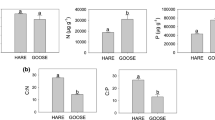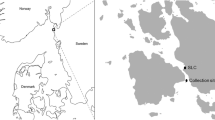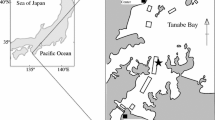Abstract
The significance of the microheterotrophic utilization of faecal pellets derived from Gibbula umbilicaris — one of the most important gastropod species in the Posidonia oceanica ecosystem around the Isle of Ischia (Italy) — was investigated by means of microcosm-experiments. Initial total organic carbon (TOC) content of faecal pellets was 32 μgC (mg faeces dry wt)-1 and declined continuously over a 2-month incubation period. The low values of TOC coincided with SEM observations of pellets which were found to consist mainly of diatom frustules and other slowly utilizable material. In a long-term experiment freshly egested faecal pellets were rapidly colonized by bacteria, which reached densities of up to 14x105 cells (mg faeces dry wt)-1 within 12 h. Thereafter bacterial numbers declined and fluctuated in a very narrow range between 2 and 3.5x105 cells (mg faeces dry wt)-1 during the two months of the investigation period. In short-term experiments (over 5 d) similar trends were observed. Peak densities of attached bacteria were followed by a decline of this population. Concurrently the number of free-living bacteria increased. This observation was confirmed by O2 consumption measurements of freshly egested faecal pellets over 24 h, where the highest O2 consumption rates were obtained after 12 h, followed by a rapid decline, thus supporting the view that detachment of bacteria may occur. Moreover, the respiration data indicate that about 4% of faecal TOC are remineralized within the first day.
Similar content being viewed by others
Literature cited
Azam, F., T. Fenchel, J. G. Field, J. S. Gray, L.-A. Meyer-Reil and F. Thingstad: The ecological role of water-column microbes in the sea. Mar. Ecol. Prog. Ser. 10, 257–263 (1983)
Bell, W. H.: Bacterial utilization of algal extracellular products. 3. The specificity of algal-bacterial interaction. Limnol. Oceanogr. 28, 1131–1143 (1983)
Chrost, R. J.: Plankton photosynthesis, extracellular release and bacterial utilization of dissolved organic carbon (RDOC) in lakes of different trophy. Acta Microbiol. Pol. 32, 275–287 (1983)
Daley, R. J.: Direct epifluorescence enumeration of native aquatic bacteria: uses, limitations and comparative accuracy. In: Native aquatic bacteria: enumeration, activity and ecology, pp 29–45. Ed. by J. W. Costerton and R. R. Colwell. Philadelphia: American Society for Testing and Materials 1979
Elliot, J. W. and W. Davison: Energy equivalents of oxygen consumption in animal energetics. Oecologia (Berl.) 19, 195–201 (1975)
Es, van F. B. and L.-A. Meyer-Reil: Biomass and metabolic activity of heterotrophic marine bacteria. Adv. microb. Ecol. 6, 111–170 (1982)
Fenchel, T.: Studies on the decomposition of organic detritus derived from the turtle grass Thallassia testudinum. Limnol. Oceanogr. 15, 14–20 (1970)
Fuhrman, J. A. and G. B. McManus: Do bacteria-sized marine eukaryotes consume significant bacterial production? Science, Wash. D.C. 224, 1257–1260 (1984)
Fukami, K., U. Simidu and N. Taga: Change in a bacterial population during the process of degradation of a phytoplankton bloom in a brackish lake. Mar. Biol. 76, 253–255 (1983)
Fukami, K., U. Simidu and N. Taga: Microbial decomposition of phyto- and zooplankton in seawater. I. Changes in organic matter. Mar. Ecol. Prog. Ser. 21, 1–5 (1985a)
Fukami, K., U. Simidu and N. Taga: Microbial decomposition of phyto- and zooplankton in seawater. II. Changes in the bacterial community. Mar. Ecol. Prog. Ser. 21, 7–13 (1985b)
Gowing, M. M. and M. W. Silver: Origins and microenvironments of bacteria mediating fecal pellet decomposition in the sea. Mar. Biol. 73, 7–16 (1983)
Herndl, G. J. and B. Velimirov: The microheterotrophic utilization of mucus released by the Mediterranean coral Cladocora cespitosa. Mar. Biol. 90, 363–369 (1986)
Hobbie, J. E., R. J. Daley and S. Jasper: Use of Nuclepore filters for counting bacteria by fluorescence microscopy. Appl. envir. Microbiol. 33, 1225–1228 (1977)
Honjo, S. and M. R. Roman: Marine copepod fecal pellets: production, preservation and sedimentation. J. mar. Res. 36, 45–57 (1978)
Iturriaga, R. and M.-G. Hoppe: Observations of heterotrophic activity on photoassimilated organic matter. Mar. Biol. 40, 101–108 (1977)
Iturriaga, R. and A. Zsolnay: Heterotrophic uptake and transformation of phytoplankton extracellular products. Bot. mar. 26, 375–381 (1983)
Jacobsen, T. R. and F. Azam: Role of bacteria in copepod fecal pellet decomposition: colonization, growth rates and mineralization. Bull. mar. Sci. 35, 495–502 (1984)
Joint, I. R. and R. J. Morris: The role of bacteria in the turnover of organic matter in the sea. Oceanogr. mar. Biol. A. Rev. 20, 65–118 (1982)
Kirchman, D.: The production of bacteria attached to particles suspended in a freshwater pond. Limnol. Oceanogr. 28, 858–872 (1983)
Knauer, G. A., J. H. Martin and K. W. Bruland: Fluxes of particulate organic carbon, nitrogen, and phosphorus in the upper water column of the Northeast Pacific. Deep-Sea Res. 26, 97–108 (1979)
Lancelot, C.: Factors affecting phytoplankton extracellular release in the Southern Bight of the North Sea. Mar. Ecol. Prog. Ser. 12, 115–121 (1983)
Lee, J. J.: A conceptual model of marine detrital decomposition and the organisms associated with the process. Adv. aquat. Microbiol. 2, 257–291 (1980)
Linley, E. A. S. and J. G. Field: The nature and ecological significance of bacterial aggregation in a nearshore upwelling ecosystem. Estuar. cstl Shelf Sci. 14, 1–11 (1982)
Linley, E. A. S. and R. C. Newell: Estimates of bacterial growth yields based on plant detritus. Bull. mar. Sci. 35, 409–425 (1984)
Linley, E. A. S., R. C. Newell and S. A. Bosma: Heterotrophic utilization of mucilage released during fragmentation of kelp (Eclonia maxima and Laminaria pallida). I. Development of microbial communities associated with the degradation of kelp mucilage. Mar. Ecol. Prog. Ser. 4, 31–41 (1981)
Lucas, M. I., R. C. Newell and B. Velimirov: Heterotrophic utilization of kelp (Ecklonia maxima and Laminaria pallida). II. Differential utilization of dissolved organic components from kelp mucilage. Mar. Ecol. Prog. Ser. 4, 43–55 (1981)
Mazzella, L. and J. A. Ott: Seasonal changes in some features of Posidonia oceanica (L.) Delile leaves and epiphytes at different depths. In: First Int. Workshop Posidonia oceanica Beds, pp 119–127. Ed. by C. F. Boudouresque, A. Jeudy de Grissac and J. Olivier. Marseille: G. I. S. Posidonie 1984
McCave, I. N.: Vertical flux of particles in the ocean. Deep-Sea Res. 22, 491–502 (1975)
Newell, R. C., M. I. Lucas and E. A. S. Linley: The rate of degradation and efficiency of conversion of phytoplankton debris by marine micro-organisms. Mar. Ecol. Prog. Ser. 6, 123–136 (1981)
Newell, R. C., J. G. Field and C. L. Griffiths: Energy balance and significance of micro-organisms in a kelp bed community. Mar. Ecol. Prog. Ser. 8, 103–113 (1982)
Newell, R. C., E. A. S. Linley and M. I. Lucas: Bacterial production and carbon conversion based on saltmarsh plant debris. Estuar. cstl Shelf Sci. 17, 405–419 (1983)
Novak, R.: A study in ultra-ecology: Microorganisms on the seagrass Posidonia oceanica (L.) Delile. P.S.Z.N.I.: Mar. Ecol. 5, 143–190 (1984)
Novitsky, J. A.: Heterotrophic activity throughout a vertical profile of seawater and sediment in Halifax Harbor, Canada. Appl. envir. Microbiol. 45, 1753–1760 (1983a)
Novitsky, J. A.: Microbial activity at the sediment-water interface in Halifax Harbor, Canada. Appl. envir. Microbiol. 45, 1761–1766 (1983b)
Paerl, H. W.: Microbial attachment to particles in marine and freshwater ecosystems. Microb. Ecol. 2, 73–83 (1975)
Paerl, H. W. and S. L. Shimp: Preparation of filtered plankton and detritus for study with scanning electron microscopy. Limnol. Oceanogr. 18, 802–805 (1973)
Peduzzi, P.: Oxygen consumption of two characteristic gastropod-species in a Posidonia oceanica (L.) Delile community. In: Second Int. Workshop Posidonia oceanica Beds. Ed. by C. F. Boudouresque. Marseille: G. I. S. Posidonie (In press)
Pomeroy, L. D. and D. Deibel: Aggregation of organic matter by pelagic tunicates. Limnol. Oceanogr. 25, 643–652 (1980)
Pomeroy, L. R., R. B. Hanson, P. A. McGillivary, B. F. Sherr, D. Kirchman and D. Deibel: Microbiology and chemistry of fecal products of pelagic tunicates: rates and fates. Bull. mar. Sci. 35, 426–439 (1984)
Pregnall, A. M.: Release of dissolved organic carbon from the estuarine intertidal macroalga Enteromorpha prolifera. Mar. Biol. 73, 37–42 (1983)
Rublee, P. A., H. R. Lasker, M. Gottfried and M. R. Roman: Production and bacterial colonization of mucus from the soft coral Briarium asbestinum. Bull. mar. Sci. 30, 888–893 (1980)
Small, L. F., S. W. Fowler and M. Y. Ünlü: Sinking rates of natural copepod fecal pellets. Mar. Biol. 51, 233–241 (1979)
Sorokin, Y. I.: Decomposition of organic matter and nutrient regeneration. In: Marine ecology, vol. IV, pp 501–616. Ed. by O. Kinne. Chichester: Wiley 1978
Stuart, V., M. I. Lucas and R. C. Newell: Heterotrophic utilization of particulate matter from kelp, Laminaria pallida. Mar. Ecol. Prog. Ser. 4, 337–348 (1981)
Stuart, V., R. C. Newell and M. I. Lucas: Conversion of kelp debris and faecal material from the mussel Aulacomya ater by marine micro-organisms. Mar. Ecol. Prog. Ser. 7, 47–57 (1982)
Turner, J. T. and J. G. Ferrante: Zooplankton fecal pellets in aquatic ecosystems. BioSci. 29, 670–677 (1979)
Urrere, M. A. and G. A. Knauer: Zooplankton fecal pellet fluxes and vertical transport of particulate organic material in the pelagic environment. J. Plankton Res. 3, 369–387 (1981)
Velimirov, B.: DOC dynamics in a Mediterranean seagrass system. Mar. Ecol. Prog. Ser. 28, 21–41 (1986)
Velimirov, B., J. A. Ott and R. Novak: Microorganisms on macrophyte debris: biodegradation and its implication in the food web. Kiel. Meeresforsch., Sonderheft 5, 333–344 (1981)
Wiebe, W. J. and D. F. Smith: Direct measurement of dissolved organic carbon release by phytoplankton and incorporation by microheterotrophs. Mar. Biol. 42, 213–223 (1977)
Williams, P. J. leB.: Bacterial production in the marine food chain: the emperor's néw suit of clothes? In: Flows of energy and materials in marine ecosystems, pp 271–299. Ed. by M. J. R. Fasham. New York: Plenum Press 1984
Author information
Authors and Affiliations
Additional information
Communicated by O. Kinne, Oldendorf/Luhe
Rights and permissions
About this article
Cite this article
Peduzzi, P., Herndl, G.J. Role of bacteria in decomposition of faecal pellets egested by the epiphyte-grazing gastropod Gibbula umbilicaris . Marine Biology 92, 417–424 (1986). https://doi.org/10.1007/BF00392682
Accepted:
Published:
Issue Date:
DOI: https://doi.org/10.1007/BF00392682




